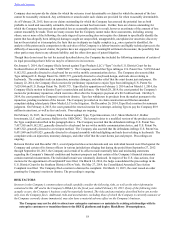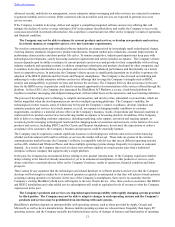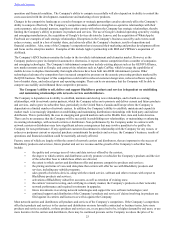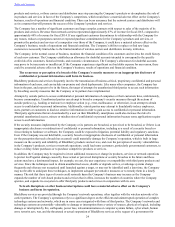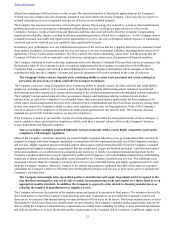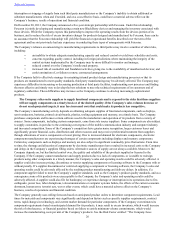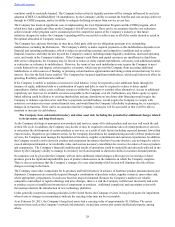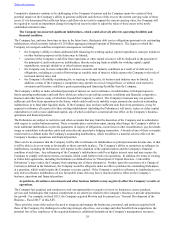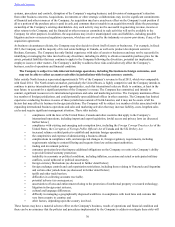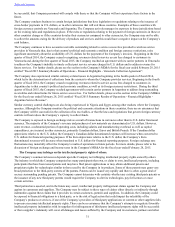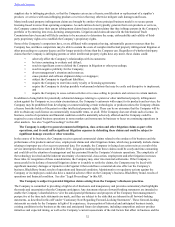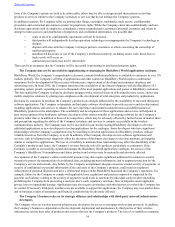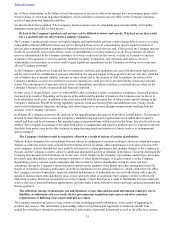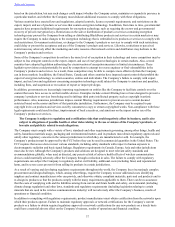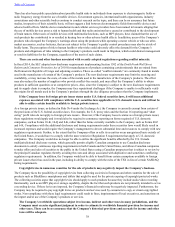Blackberry 2015 Annual Report Download - page 37
Download and view the complete annual report
Please find page 37 of the 2015 Blackberry annual report below. You can navigate through the pages in the report by either clicking on the pages listed below, or by using the keyword search tool below to find specific information within the annual report.
Table of Contents
28
condition could be materially harmed. The Company believes that its liquidity position will be strongly influenced by end user
adoption of BES 12 and BlackBerry 10 smartphones, by the Company’s ability to sustain the benefits and cost savings achieved
through its CORE program, and by its ability to mitigate declining revenues from service access fees.
The Company has incurred significant costs in implementing the Cost Optimization Program and the CORE program, all of
which have had a significant effect on the Company's GAAP net income. There can be no assurance that the cost reductions
achieved under either program can be sustained given the competitive nature of the Company’s industry or that future
initiatives designed to reduce the Company’s spending will be successful or achieve any or all of the results desired or result in
the optimal allocation of Company resources.
The Company has, and may from time to time have, third party debt service obligations pursuant to its outstanding
indebtedness, including the Debentures. The Company's ability to make required payments on this indebtedness depends on its
financial and operating performance, which is subject to prevailing economic and competitive conditions and to certain
financial, business, and other factors beyond the Company's control, including market liquidity conditions, increased operating
costs, and trends in the Company's industry. If the Company's cash flows and capital resources are insufficient to fund these
debt service obligations, the Company may be forced to reduce or delay capital expenditures, sell assets, seek additional capital,
or restructure or refinance its indebtedness. However, the terms of any such indebtedness may require the Company to meet
certain financial tests and impose certain negative covenants, which may prevent the Company from accessing additional
indebtedness or other sources of funding, or pursuing certain business opportunities and taking certain actions that may be in its
interest. See also the Risk Factor entitled “The Company has incurred significant indebtedness, which could adversely affect its
operating flexibility and financial condition”.
If the Company is unable to maintain or increase its cash balance, it may be required to raise additional funds through the
issuance of equity, additional debt or a combination of equity and debt, or may be required to reduce or delay capital
expenditures, further reduce costs, reallocate resources within the Company or consider other alternatives. Access to additional
capital may not, however, be available on terms acceptable to the Company or at all. Furthermore, any future equity or equity-
linked offering could be dilutive to existing shareholders and any drawdown on any future debt financing would require the
Company to dedicate a portion of its cash flow to payments on indebtedness, would require the Company to comply with
restrictive covenants or to meet certain financial tests, and would limit the Company’s flexibility in planning for, or reacting to,
changes in its business. There can be no assurance that the Company’s strategies will be successful or that it will be able to
maintain or increase its cash balance.
The Company faces substantial inventory and other asset risk, including the potential for additional charges related
to its inventory and long-lived assets.
As the Company develops or announces new products and services, many of its older products and services will reach the end
of their life cycle. In addition, the Company may decide or may be required to discontinue sales of certain products or services,
or not pursue the development of certain products or services, as a result of such factors including expected demand, lower than
expected sales, litigation or government action. As the Company discontinues the manufacturing and sale of these products and
services, the Company must manage the liquidation of inventory, supplier commitments and customer expectations. In addition,
the Company records a write-down for product and component inventories that have become obsolete, can no longer be sold or
exceed anticipated demand or net realizable value, and accrues necessary cancellation fee reserves for orders of excess products
and components. The Company’s financial condition and results of operations could be materially and adversely affected in the
future by the Company’s ability to manage its inventory levels and respond to short-term shifts in customer demand patterns.
No assurance can be given that the Company will not incur additional related charges with respect to its existing or future
products given the rapid and unpredictable pace of product obsolescence in the industries in which the Company competes.
There is also no assurance that the Company’s strategic five year relationship with Foxconn will eliminate the risk of these
charges occurring in the future.
The Company must order components for its products and build inventory in advance of hardware product announcements and
shipments. Components are normally acquired through a combination of purchase orders, supplier contracts, open orders and,
where appropriate, prepayments, in each case based on projected demand. Because the Company’s markets are volatile,
competitive and subject to rapid technology and price changes, there is a risk the Company will forecast incorrectly and order
or produce excess or insufficient inventories of components or products. Additional complexity and uncertainty exists with
forecasting related to the introduction of new technology platforms.
Under generally accepted accounting principles in the United States, the Company reviews its long-lived assets for impairment
when events or changes in circumstances indicate the carrying value may not be recoverable.
As at February 28, 2015, the Company’s long-lived assets had a carrying value of approximately $1.9 billion. The assets
represent items such as the Company’s network infrastructure, owned data centres and certain intellectual property, among
others.


